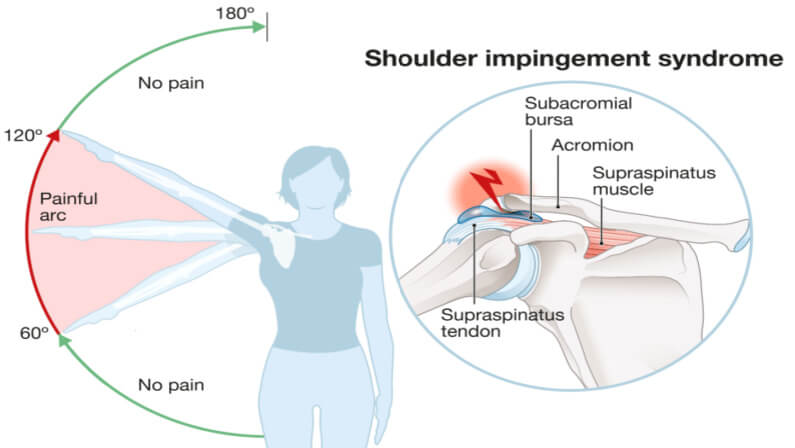The shoulder joint is an incredibly complex mechanism that enables us to perform myriad tasks every day, from reaching for the cereal box in the kitchen cupboard to throwing a ball, to playing the drums. Unfortunately, the shoulder joint is susceptible to certain issues such as impingement due to its complexity and reliance on a wide range of muscles.
If you’re curious what shoulder impingement is, it’s a condition in which the shoulder joint becomes compressed and irritated due to tightness or inflammation of surrounding muscles. This leads to pain when performing certain activities, weakness or instability in the shoulder, and reduced range of motion.
To learn more about this shoulder condition and how to fix it, keep reading.
What is shoulder impingement?
Shoulder impingement occurs when the rotator cuff tendons become compressed within the space between your shoulder blade and upper arm bone (the subacromial space). This space is much smaller than the normal range of motion, so any increase in movement can lead to irritation and inflammation.
Moreover, shoulder impingement can be caused by the inflammation of any of the four muscles that control your shoulder movements. This often occurs when the tendons become damaged due to repetitive use, overstretching, or playing sports and other activities that put a lot of strain on your shoulders.
Who gets shoulder impingement?
A shoulder impingement can affect anyone, regardless of age or activity level. However, it’s most common in people who do a lot of overhead activities such as throwing sports, weight-lifting, and painting.
It’s also worth noting that shoulder impingement is more likely to occur if you have an underlying condition like rotator cuff tendinopathy, adhesive capsulitis (frozen shoulder), or bursitis.
How common is shoulder impingement?
People who engage in frequent overhead activities are more likely to experience shoulder impingement. However, it’s also important to note that even people who don’t engage in these activities can still get shoulder impingement. In fact, according to some estimates, up to a third of all adults will experience this condition at some point in their lives.
Shoulder impingement symptoms

There are different levels of shoulder impingement and the symptoms can range from mild to severe.
Common signs that you may be experiencing a shoulder impingement include:
- Pain when lifting your arm above your head
- Weakness in the affected arm
- Limited range of motion
- Stiffness or soreness in the affected area
- Sudden pain when performing overhead activities
These symptoms are usually worse when you perform certain activities or positions, such as reaching above your head or lying on the affected side.
What causes shoulder impingement?
Several causes can be attributed to shoulder impingement, including:
- Repetitive overhead activities
- Poor posture
- Weak rotator cuff muscles
- Aging or wear and tear of the tendons
- Overstretching or overuse of the shoulder joint
- Injury to the rotator cuff muscles or tendons
In addition, shoulder impingement can also be caused by underlying conditions like rotator cuff tendinopathy, adhesive capsulitis (frozen shoulder), or bursitis.
Who’s at risk of having shoulder impingement?
People who constantly feel the urge to lift their arms above their heads or engage in repetitive overhead activities are at higher risk of shoulder impingement. This includes athletes, weightlifters, swimmers, painters, and any other profession that involves frequent lifting of the arms.
In addition, people with an underlying condition like rotator cuff tendinopathy, adhesive capsulitis (frozen shoulder), or bursitis are also at a higher risk of having shoulder impingement.
How to diagnose shoulder impingement?

Doctors can diagnose shoulder impingement using a physical exam and imaging tests such as X-rays or an MRI.
Here is how they diagnose a shoulder infringement:
- Physical Exam – Your doctor will inspect your shoulder for signs of swelling and tenderness. They will also have you perform certain movements to check for a range of motion, strength, and discomfort.
- X-ray – X-rays are used to get an image of the bone structure in your shoulder. It can help diagnose fractures or dislocations but won’t show the soft tissue damage that occurs with shoulder impingement.
- MRI – Magnetic Resonance Imaging (MRI) is a type of imaging test used to get an image of the soft tissues in your shoulder. It can help diagnose any underlying conditions or structural changes caused by impingement.
After these tests, your doctor may recommend a course of treatment. With that, if you experience pain in your shoulder, you should rush to the nearest emergency room in your area!
How to treat shoulder impingement?
Treatment for shoulder impingement depends on the underlying cause and severity of the condition.
Your doctor may suggest one or more of the following treatments:
Home Care
Since shoulder impingement is caused by overuse or repetitive activities, your doctor may recommend taking a break from any overhead activity for a few days. This will give the joint time to rest and heal. You can also use ice packs to reduce inflammation, and take over-the-counter pain medications as needed.
Physical Therapy

Your doctor may refer you to a physical therapist for rehabilitative exercises. These exercises are designed to strengthen the rotator cuff muscles and improve the range of motion in the shoulder joint. Your physical therapist may also recommend lifestyle changes, such as improving your posture or changing how you perform certain activities.
Medication
In most cases, your doctor will prescribe nonsteroidal anti-inflammatory drugs (NSAIDs) to reduce inflammation and pain. Doctors also sometimes prescribe corticosteroid injections to help reduce pain and swelling.
Surgery
If the condition is severe, your doctor may recommend surgery to remove any loose fragments of bone or tissue that are causing the impingement. After surgery, you may need physical therapy for several weeks to strengthen the muscles and regain your full range of motion.
Shoulder Impingement Recovery Time
The recovery time of shoulder impingement depends on the severity of the condition and how well you follow your doctor’s instructions. Most people can expect to make a full recovery within four to six weeks, but it may take longer depending on the treatment regimen.
Exercise for Shoulder Impingement
Doctors also advise people with shoulder impingement to perform certain exercises to help strengthen the muscles in the shoulder and improve their range of motion.
Some of these exercises include:
- Shoulder rolls
- Arm circles
- Cuban presses
- Reverse flys
- External rotation
These exercises should be done under the supervision of a physical therapist or doctor.
Shoulder impingement exercises to avoid
Aside from the exercises above, there are certain activities to avoid with shoulder impingement.
These include:
- Heavy lifting
- Pushing or pulling heavy objects
- Throwing activities
- Overhead motions such as reaching or stretching up high.
It is important to follow your doctor’s instructions and take breaks from any activities that cause pain or discomfort.
Have Your Shoulder Checked and Treated

Shoulder impingement is a common condition that can cause pain and limited mobility in the shoulders. It’s important to see your doctor if you experience shoulder pain, as early diagnosis and treatment can prevent more serious complications. By following your doctor’s instructions, you can help ensure a quick and successful recovery.
If left untreated, shoulder impingement can lead to permanent joint damage and disability. It is therefore important that you follow the recommended treatment plan and take steps to prevent further injury. With the right care, many people are able to make a full recovery in no time.
If you live in Pearland, TX and you need to run your shoulder to the doctor, Aether Health – SilverLake ER is here to help. Our experienced team of medical experts can diagnose and treat shoulder impingement quickly and effectively. So don’t wait—contact us today to schedule an appointment.
We look forward to helping you find relief!








